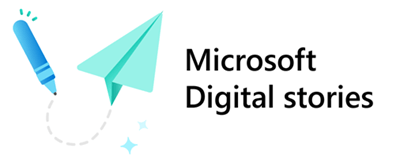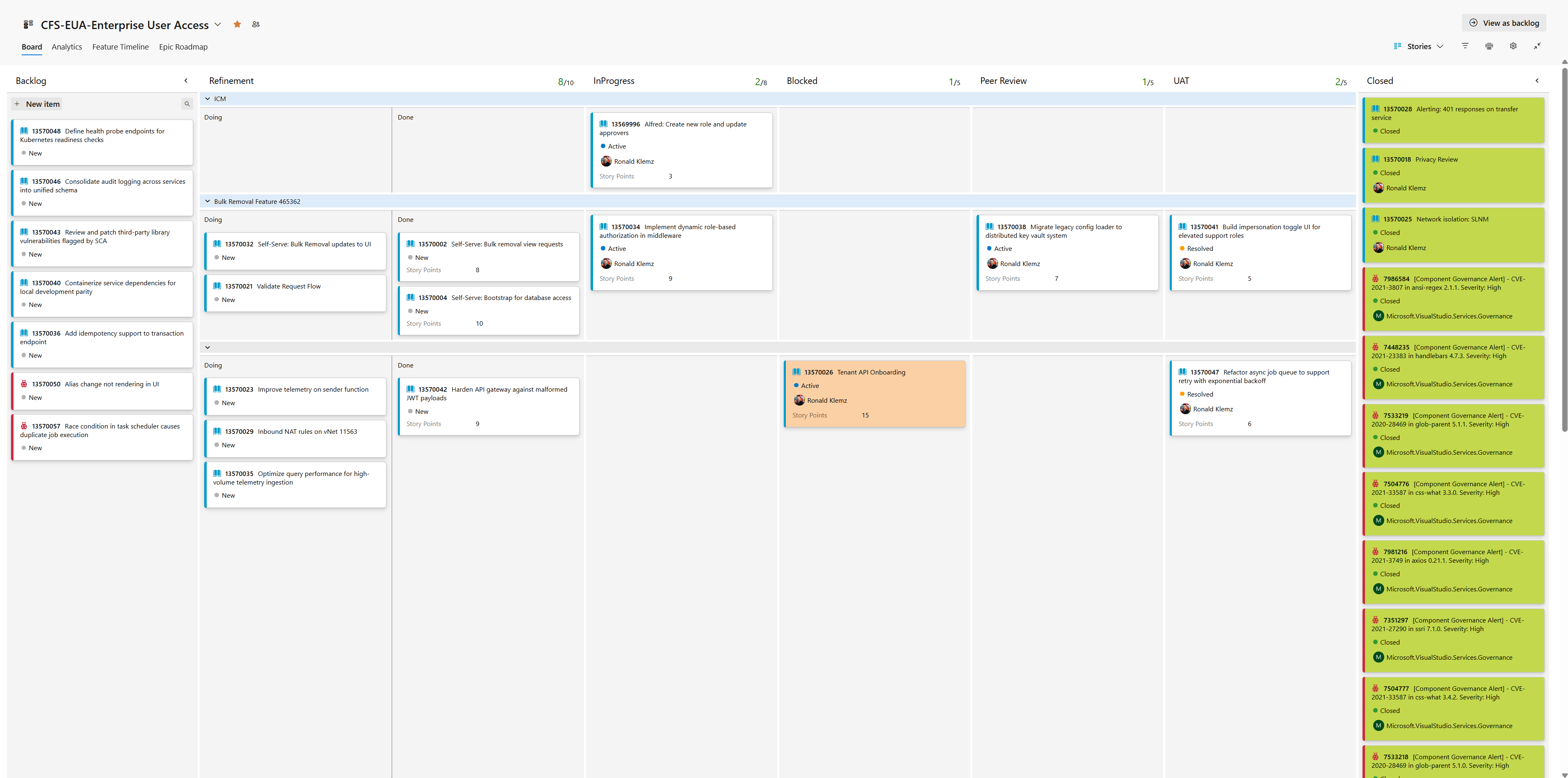
At Microsoft we’ve taken a page from the auto industry and have adopted a process called Kanban. Kanban (pronounced “con-bon”) is a Japanese word meaning “signboard” or “billboard.” It was first developed by a Toyota engineer decades ago to improve manufacturing efficiency.
Today, we’re using Kanban to drive improvement and streamline workflows within some of our engineering teams. The process shows great potential to encourage innovation and increase engineering excellence.
In its simplest form, Kanban involves creating a set of cards that track manufacturing or other step-by-step processes. These cards, tacked to a corkboard, can be used to highlight trouble spots and avoid overcapacity. That latter quality helps Kanban users resist loading up a job with too many side tasks.
“I learned about Kanban when I was in the Marine Corps,” says Ronald Klemz, a senior software engineer manager on our Microsoft Commerce and Ecosystems team. “When I joined Microsoft, I could see how it applied to software engineering.”
Less meetings, more flexibility
Although Kanban has gradually grown in popularity at Microsoft, many engineers still rely on the scrum development framework (part of the agile software development methodology). Scrums consist of regular planning meetings, followed by two-week to month-long sprints that are designed to complete a particular stage of work.
While plenty of good work has come out of scrums and agile, they are not always ideal for driving engineering improvement. The regular scrum meetings can be time-consuming; even though they are designed to break big jobs into manageable pieces, teams can still become overwhelmed if customers add new requirements on the fly.

“At the start of each two-week scrum cycle, you’re expected to know everything that you’re going to do in those two weeks,” says Snigdha Bora, an engineering lead with Microsoft Digital, the company’s IT organization. “But there are things that will happen in those two weeks that you can’t know in advance. All of that goes away with Kanban, because it has no artificial boundaries or time limitations.”
Klemz agrees.
“We’d spend so much time in meetings, planning and replanning to ensure our commitments were falling in the sprint window,” Klemz says. “That would result in large work items sitting in the Active column for days or weeks, making it really difficult to visualize the state of the work. To reduce the meeting load and free up our engineers, we decided to give Kanban a try—and we’ve never looked back.”
Balancing workloads and resources
Whether built with simple paper materials or using more sophisticated software versions, a Kanban board shows rows of cards arranged in columns that represent stages of a project’s workflow. Each card contains a specific task and who is responsible for it.
One of Kanban’s most valuable aspects is that each column is designed to self-limit work in progress. If an extra card is added that exceeds the agreed upon limit of tasks, the column heading might light up red, indicating a possible bottleneck that could delay work.
“It helps to simplify the workflow, so people aren’t getting hit with all kinds of sudden, ad hoc projects,” Klemz says. “They’re able to focus on the agreed-upon workflow.”
Kanban also helps engineers easily shift gears as priorities change and challenges arise.
“Kanban really helps us have the flexibility to tackle urgent work without entirely disrupting the state of our planning cycle,” Klemz says. “When you have a small team responsible for many downstream systems, there are bound to be unknowns that surface and suddenly become top priority. By leveraging Kanban, we’re able to break our work into smaller tasks, so that an engineer can switch projects to focus on an urgent issue.”
Virtual Kanban board at Microsoft

That last point underscores another advantage of how Kanban drives engineering improvement at Microsoft: Its visual nature makes it easy for someone who is a newcomer to a team, has been on vacation, or is a part-timer to look at the Kanban board and immediately see what needs to be done.
“With a Kanban board, an employee can pick up any unassigned task without having to consult the project manager on the priority,” Bora says. “This is much easier and more efficient.”
This feature is especially helpful as more Microsoft engineers are working remotely in today’s increasingly hybrid workforce, frequently across various time zones. By checking the Kanban boards, many of which are created with Microsoft Azure DevOps, they can quickly grasp the status of a project at any time.
Enabling greater collaboration and transparency
The Microsoft Commerce and Ecosystem team owns the tools, processes, and controls to ensure that Microsoft’s preferred suppliers and partners are paid in a timely way once invoices are approved. They also ensure that tax and other statutory laws are followed globally, provide tax and statutory compliance information, and report payments to the Internal Revenue Service.
Those multiple workflows often led to siloed work, with different members of the team unaware of what co-workers were doing, or how their work affected others.
Kanban has helped the team create a more collaborative work environment while still giving engineers plenty of freedom for innovation, which has positively impacted both business needs and the customer experience.
“It’s an effective approach to delivering software iteratively,” Bora says. “It brings so much transparency for the team by providing better visualization to track progress.”
The increased agility plays well with Microsoft customers, who have become accustomed to rapid and seamless product improvements. The same goes for internal business changes, such as the expansion of Microsoft Azure and data center launches and announcements.
According to team leaders, Kanban allows them to quickly respond to these strategic shifts, enabling real-time transparency and close tracking of OKRs (Objectives and Key Results). The Kanban dashboards also allow them to more easily give global stakeholders insight into project progress, which builds stronger trust among all parties.
Kanban also helps the organization more effectively manage global statutory laws and compliance processes, which can change rapidly (including predefined timelines that in most cases are non-negotiable).
Adopting Kanban continues to be a learning process for Microsoft engineers, and the discipline is gradually becoming more widely accepted in the tech industry. It shows great potential for making software development faster and more trouble-free, while helping teams work together more flexibly and effectively.

Here are some of the advantages that Kanban can bring to help improve workflow processes at your organization:
- It elevates flexibility over rigid frameworks. Unlike scrums, Kanban doesn’t enforce strict timeboxes (like sprints). This flexibility helps teams adapt to unexpected changes and evolving requirements without disruption.
- Visual workflow = instant clarity. Kanban’s visual boards help engineers and stakeholders easily see the state of work at any time. This is especially useful for remote, hybrid, or globally distributed teams.
- The work-in-progress limits prevent bottlenecks. The columns on a Kanban board can be set to limit the number of active tasks. This helps teams stay focused, avoid burnout, and reduce delays in the workflow.
- It enables better collaboration and reduces siloed work. Kanban promotes shared visibility and team-wide alignment while eliminating siloed efforts, ensuring that everyone is moving toward common business outcomes.
- It increases agility at scale. Kanban has helped Microsoft adjust to increasingly faster business cycles, supporting major product rollouts, organizational changes, and statutory compliance across global markets with speed and confidence.








